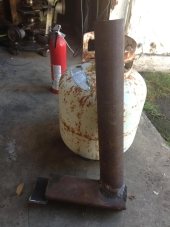











Buy the book already, sheesh. http://www.rocketstoves.com/




Success has a Thousand Fathers , Failure is an Orphan
LOOK AT THE " SIMILAR THREADS " BELOW !















Success has a Thousand Fathers , Failure is an Orphan
LOOK AT THE " SIMILAR THREADS " BELOW !


























God of procrastination https://www.youtube.com/watch?v=q1EoT9sedqY




Satamax Antone wrote:Michael, it ain't a rocket without insulation.

Satamax Antone wrote:Oh, and by the way, metal is doomed!






God of procrastination https://www.youtube.com/watch?v=q1EoT9sedqY










Success has a Thousand Fathers , Failure is an Orphan
LOOK AT THE " SIMILAR THREADS " BELOW !








Buy the book already, sheesh. http://www.rocketstoves.com/





God of procrastination https://www.youtube.com/watch?v=q1EoT9sedqY




Satamax Antone wrote:Michael, do you know what is a "Petter channel" ? Or P channel





Perfect explanation, that was invented by Peter van den Berg. It's an air channel which, even if you have most of the feed tube blocked by sticks, will let air in to help for a better combustion.Kirk Mobert wrote:I think Ernie's said this already, but..
If the feed box is larger than the burn tunnel, it WILL smoke back.
If you want to fool with the feed at all, make a reducer cap that fits over the top. Reduce the intake to somewhere between 1/4 - 1/3 system size, you'll have to play with it a bit here to get it right. You'll have to cut yer firewood short enough to fit under the cap. The reduction will accelerate incoming air, it will blow on the fire harder, making it burn hotter and giving it more whoosh.. There's a balance here.. On one hand, as Ernie said, it will move things through faster giving it less time to burn completely. On the other hand, it will burn hotter, shortening the time you need for total combustion. Timing is everything. A smaller opening will blow faster (up to limits) but allow a smaller volume of air into the fire per time unit.
Going too far in either direction (of opening size) will fail the stove, the goal is to find the sweet spot for your particular situation.
Another feed modification is the "Peter Channel", which is an air channel at the front of the feed that is the entire width of the feed box, it should be quite thin and made out of something that will conduct heat well like metal. The area of the channel should be between 5% and 7% of system size, the bottom of the separating piece should protrude down (into the burn tunnel/feed junction) the same depth as as the gap width of the channel. Also, the top should stick out a bit to separate the air flows.
In a stove without the Peter Channel, when wood in the feed box leans forward it will choke off the air a bit causing a relatively dirty burn. Also, the first brick of the burn tunnel gets really hot and will crack but more than that, when you experience "flame creep" (when fire climbs up the wood and out the feed, usually experienced burning soft-woods.) it's usually comes from right in front where the wood is ignited (I think) by touching that first brick. The Peter Channel solves all that by cooling the front brick, keeping the wood off said brick and always providing a quantity of air downwind, right into the path of combustion.
I made the one in my shower house from a chunk of an old water heater tank..
I beat it flat over an anvil, bent the tabs in a vice (with convincing hammer blows), then ground to size and fit.
You can see there's some kind of baked on enamel that coated the inside of the tank. It's quite resilient stuff, only really comes off when it's banged HARD between sledge and anvil.
Notice how the wings are bent? The way they set, makes it fall tight against the face of the brick and keep it there. You can accentuate the effect by notching out the underside of the wings a little at their "arm-pits".
God of procrastination https://www.youtube.com/watch?v=q1EoT9sedqY
















God of procrastination https://www.youtube.com/watch?v=q1EoT9sedqY




Satamax Antone wrote:So, now that you discovered temp differential, when will you insulate?

Buy the book already, sheesh. http://www.rocketstoves.com/










Success has a Thousand Fathers , Failure is an Orphan
LOOK AT THE " SIMILAR THREADS " BELOW !





God of procrastination https://www.youtube.com/watch?v=q1EoT9sedqY




Satamax Antone wrote:So, now that you discovered temp differential, when will you insulate?

allen lumley wrote:We generally say that a clay mortar is not to hold the bricks together, but to hold them far enuf apart to make for easy leveling ! Ordinarily I would just recommend
A very quick dip in water followed by a dip in Clay Slip (think a good pancake batter !) as a good way to 'Dry stack' your bricks and get good seals around them. For you this
should be a make indoors, roll out doors project !
Big AL !
Buy the book already, sheesh. http://www.rocketstoves.com/








Buy the book already, sheesh. http://www.rocketstoves.com/




Buy the book already, sheesh. http://www.rocketstoves.com/




allen lumley wrote:Keep plugging on and reporting, the numbers at the bottom of this thread prove many people are following your evolution ! Big AL !
Buy the book already, sheesh. http://www.rocketstoves.com/










Success has a Thousand Fathers , Failure is an Orphan
LOOK AT THE " SIMILAR THREADS " BELOW !





God of procrastination https://www.youtube.com/watch?v=q1EoT9sedqY










Success has a Thousand Fathers , Failure is an Orphan
LOOK AT THE " SIMILAR THREADS " BELOW !





God of procrastination https://www.youtube.com/watch?v=q1EoT9sedqY





Buy the book already, sheesh. http://www.rocketstoves.com/












|
"Ace of Hearts" sounds a little like "Ace o Farts" - says this tiny ad:
Freaky Cheap Heat - 2 hour movie - HD streaming
https://permies.com/wiki/238453/Freaky-Cheap-Heat-hour-movie
|




